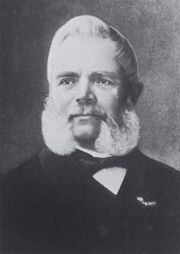Prominent Poles
Antoni Norbert Patek (aka Antoine Norbert de Patek, aka Antoni Norbert Patek de Prawdzic) Polish pioneer in watchmaking and a creator of Patek Philippe & Co. one of the most famous watchmaker companies.

Born: June 12, 1811 (or 1812), Piaski, Russian partition of Poland (presently Poland)
Died: March 1, 1877 in Geneva (Switzerland) and was buried in a local cemetery in Chatelaine.
Introduction.Patek Philippe & Co. is one of the most famous and expensive brands of wrist watches in the world. The company is one of the few notable watch companies that still make all movements in house. The 20 most expensive wristwatches sold at auctions are all from Patek Philippe & Co. The “Henry Graves” super complication pocket watch from 1933 holds the world record for the most expensive watch – sold at auction in 1999 for more than $11 million.
Early days. Father- Joachim Patek of Prawdzic Coat of Arms, mother- Anna née Piasecka . At the age of 10, Patek moved with his parents to Warsaw. His father died in 1828.
November Uprising. In 1830 Patek joined the November Uprising against Russian occupiers. In 1831 he received the rank of Second Lieutenant and was awarded the Polish military gold cross [Virtuti Militari]. After the uprising was defeated, Patek, along with tens of thousands of other Poles, was forced to leave the country. However, his intelligence and his knowledge of five languages did not go unnoticed by the Commander-in-Chief General Bem, who sent the young man first to Bamberg, Germany and later to France. In April 1833, Patek’s became an officer of the "Holy Battalion", a regiment of Polish émigrés on French soil who set out to aid the Frankfurt insurrection. Upon crossing the Swiss border, the regiment learned that the insurrection had collapsed and consequently remained in Switzerland, where they were warmly welcomed. The regiment formed the "Association of Polish Émigrés in Switzerland.”
Professional career. For some time Patek attended courses of painting by the famous Swiss painter and engraver Alexandre Calame. During his studies, Patek also went on a journey to Paris where he remained for several months. Antoni Patek started making pocket watches in 1839 in Geneva, along with his fellow Polish immigrant Franciszek Czapek. During the first 14 months Patek and Czapek ran the company alone, possibly with the help of one or two workmen. They purchased unfinished movements from various companies specialized in the manufacturing of raw movements (ebauches), sent them to a case maker to be cased, and then finished them in their shop. Patek’s activity in numerous Polish émigré organizations allowed him to keep in touch with his fellow countrymen and consequently to establish an impressive Polish clientele. Also in 1839 Patek married Marie Dénizart, a daughter of a French tradesman. They had three children: Boleslas, Leon Mecyslas and Marie Edwige. Patek and Czapek split in 1844, and in 1845 Patek started working with the French watchmaker Adrien Philippe, inventor of the keyless winding mechanism. After the crushing of the 1848 insurrection, Patek brought his assistance to the refugees arriving to Geneva and maintained the relations with the Congregation of the Resurrection of Our Lord Jesus Christ, (Polish: Zmartwychwstańcy), in Paris. Thereafter, the pope Pius IX conferred on Patek the title of count, in recognition of the services rendered within the community of the Polish emigrants. In 1851, Patek Philippe & Co was founded. Philippe became the head watchmaker. When, in 1851, Queen Victoria visited the Patek & Co. display at the first Universal Exhibition held in London, she was shown a small lady's watch, about 30 mm. in diameter, which needed no key for winding or setting. She bought it on the spot, perhaps remembering a similar watch which she had purchased several years before from Breguet. This watch was about 20 mm. in diameter, was wound by a stem and had a lever escapement. On this occasion, Prince Albert also bought himself a Patek watch. Patek became the immediate talk of the town and his company instantly gained in prestige.
The fame achieved at the London exhibition was widely publicized, and Patek's financial problems slowly began to dissipate. In 1868, Patek Philippe made their first wristwatch. They have also pioneered the perpetual calendar, split-seconds hand, chronograph and minute repeater in watches. Their everyday watches were of consistently high standards. The company was thus elevated to an almost legendary status. Patek's clients included approximately one hundred kings and queens, and at the end of his life he had the satisfaction of knowing he had become a leader in horology, the best among the best. He began to heavily publicize and market his products everywhere and became a supplier to Rodanet of Paris, Peña in Madrid, Elimayer in Leipzig, and to the biggest watch and jewelry stores elsewhere. Realizing the potential of the American market, whose biggest jeweler, Tiffany, Young & Ellis, was already his client, he traveled to USA in 1854.
Source:
This article uses, among others, material from the Wikipedia article "Antoni Patek" licensed under the GNU Free Documentation License. :
Wikipedia (Antoni Patek)
Other sources:
Wikipedia (Patek Philippe&Co)
"Patek Philippe, The Forgotten Beginnings" by Philip Poniz, Director and horological expert
PATEK PHILIPPE SA
Return to home page:
Prominent Poles
